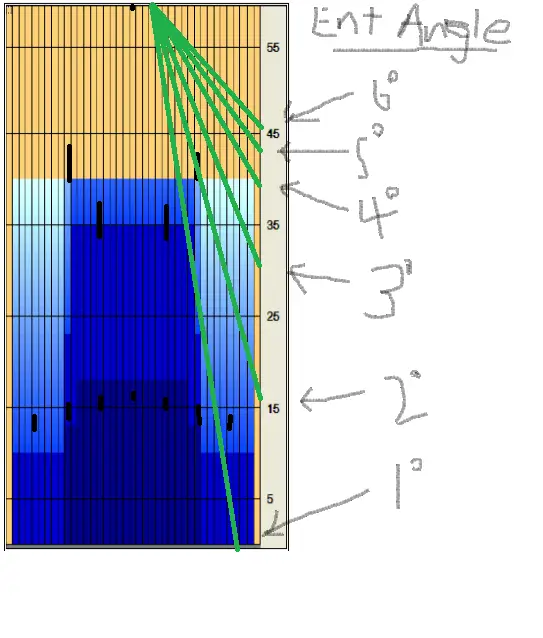
If you are reading this you are likely a competitive bowler either at your local league level or at a competitive level. Having an entry angle for getting a strike is blatantly obvious but do you know what the best entry angle for increasing strike percentage is?
Most bowlers have no idea.
Honestly, I didn’t either until I started researching this topic intensely.
We all know that hooking the ball creates angle to the pocket that cannot be achieved by throwing a straight ball alone.
In fact a straight ball thrown from the 1-board directly to the 1-3 pocket (the 18 board) achieves a mathematical entry angle of a little less than 1.5 degrees.
From the foul line it looks like the angle from the 1-board is much greater but that is just an optical illusion. Due to the length of the lane relative to your line of eye-sight based on your height at the foul line all entry angles look far bigger than they actually are.
A 5-degree entry angle looks to be roughly 45-degrees for the majority of people!
Viewed from an eagle’s eye perspective this is easy to see but from the foul line it is not.

From the foul line if you were to mentally draw a straight line from the pocket (the 17.5 board at the headpin) to gutter somewhere around 39 feet down lane (between the hash-marks near your break point) then this would roughly represent a 4-degree angle of entry to the pocket.
If you were to roll a straight ball from the gutter at 39 feet directly into the pocket that would be an approximate 4-degree entry angle and you would have roughly a 95% strike percentage!
Both Kegel and the USBC Bowling Academy have studied the strike percentage of balls entering the pocket from various angles and at various offsets to the headpin.
Most notably in my opinion was the assessment of the National Bowling Academy who tested thousands of straight balls entering the pocket at various angles that the width of the pocket for a near 100% strike percentage was around 6-degrees.
For the average bowler this angle is simply unachievable.
Only the highest rev players achieve angles in this range and only in the best of circumstances.
Most bowlers are in the 3-5 degree range and their study showed that the best entry point for all bowlers regardless of angle was the 17.5 board.
They also showed that when each angle degree was separated out individual bowler characteristics created more specialized optimal values.
To illustrate points made in this USBC video a bowler that typically bowls with a 2-degree angle of entry to the pocket had the best chance of striking (~95% of the time) when their ball entered the pocket “high” between the 17.75 and 18.5 board, roughly 2.2.75″ offset the center of the headpin.
That’s only a 3/4 board area to hit!
At a 4-degree entry angle they found that bowlers could reliably strike at a rate of 90-95% percent of the time when they got to the pocket between the 17.5 and 18.5 board.
That’s a slightly larger one board area.
At a 6-degree entry angle however the pocket expanded. Strike percentages were above 90% for any entry that hit the pocket between the 18.5 board and the 17 board.
In addition to this board and a half area bowlers also had notably higher strike percentages for low pocket strikes that hit in the 15.5 to 16 board range. Low pocket shots like this resulted in a strike roughly 75% of the time presumably due to sideways pin action created by elevated entry angles.
The main area for maximum strike percentage increased to 1 1/2 boards in width and low pocket strike areas came into play as well.
Basically what USBC discovered is that straight balls that have higher entry angles will strike more reliably at virtually all pocket entry boards ranging from 15.5 to 18.5. That’s a 3-board range nearly 3.5″ wide.
The problem you probably see with these stats however is that most bowlers don’t get to 6-degrees of angle and we don’t throw straight balls either so let me explain a bit why this is still relevant information.
First let’s consider the straight ball question.
With Proper Ball Motion A Ball Thrown With a Hook Rolls Out Before Hitting the Pocket
Some would contest this but a ball that rolls out and hits the pocket has a better shot of striking than a ball that is still hooking as it enters the pocket.
A ball should skid through the fronts hook through the mids and enter a roll phase where all axis rotation and tilt have been depleted.
Here is a slow motion video demonstrating this concept.
When a ball is in a full roll their is no friction other than drag caused by air. All energy that is left in the ball is forward momentum. Obviously faster ball speed in the roll phase will deflect less and carry better than slower ball speed but the ball is stable rolling in one direction just prior to impacting the pocket.
For a ball that is still in the hook phase as it enters the pocket you could best describe this ball as one that is in an unstable position.
It is still skidding a bit, losing energy due to friction on the lane as axis rotation and tilt are still being depleted, and it is more prone to deflection which can cause pins to fall in less than ideal patterns.
It’s true that balls entering while still in their hook phase may create more pin action it also means that higher pocket shots are more likely to deflect past the 9-pin and lower pocket shots are more likely to leave a variety of single pins.
In short balls still in the hook phase are better for higher rev and speed players so long as they don’t hit high pocket but for the average bowler this is not the case. Also, no matter what the speed and rev rate the predictability of a full roll going into the pocket is typically better for strike percentage than a ball entering the pocket while still hooking.
What a bowler should be trying to achieve is a ball that reads the lane and fully hooks in the midlane ending in a full roll somewhere in the last 5-10 feet of the lane.
Considering most standard oil patterns are between 35-45 feet long this gives every bowling ball plenty of time to turn the corner and roll straight into the pocket.
The greater your entry angle the wider the pocket becomes but of course the harder it is to get the ball into a stable roll so far down the lane unless the oil pattern matches up perfectly to your game.
What About 6-Degrees? Can’t You Do That Consistently?
The average league bowler (or competitive amateur for that matter) throws the ball off his or her hand at the foul line with a 45-degree axis rotation. That means as the ball travels down the lane most of that rotation is lost to friction on the lane as the ball flares and squares up for it’s roll phase.
To retain 5-6 degrees of rotation by the time the ball rolls means the ball must skid a long way down the lane before turning the corner sharply toward the pocket.
For reliable control on the back-end while still maintaining the best chances for carrying strikes you should look to get into the 4-5 degree zone as this will still be controllable for most bowlers in most conditions and your zones for high carry percentage will still remain near the upper end.
A full 6-degree entry angle means the ball need to end it’s hook phase really far down the lane, much further than normal patterns are designed to facilitate.
Of course it’s possible to achieve huge entry angles to the pocket on any condition but you should always let the condition dictate your play. Adjust to what the lanes give you as this will increase your strike percentage more than forcing huge angles ever will.

